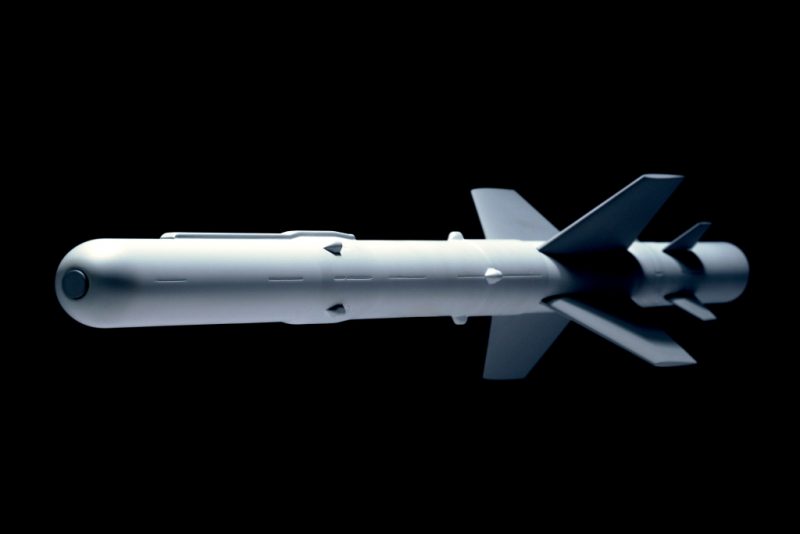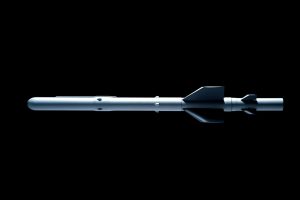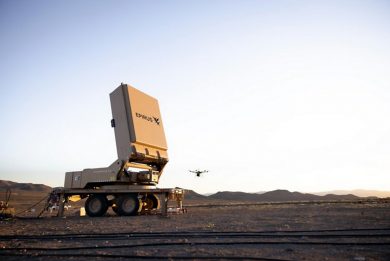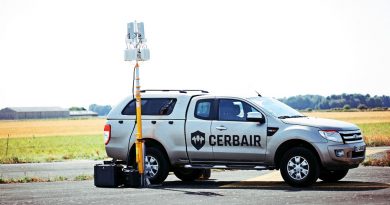Nimbrix, the new C-UAS missile that adds a further layer to the Saab anti-drone offer
At the incoming edition of DSEI, the London exhibition that will take place September 9-12, the Saab stand will be dominated by the latest product of the Swedish company, the Nimbrix, a small, inexpensive missile designed for the C-UAS mission
The UAS threat is varied, going from military-grade products to commercial off-the-shelf low cost systems, the level of technology involved being often replaced by the high number of systems used to attack a target, numbers being inversely proportional to cost. Countering swarms is an issue, however dealing with the threat at too short ranges might become a danger, hence a layered defence is probably the best solution, mimicking what is done at longer ranges for proper ground-based air defence systems.
The cost-per-kill value is definitely an issue, using expensive missiles to down a threat which is valued a few thousands euros, and even less, being a non-sustainable solution. On the other hand the AAA, the gun solution, might often have a too short range, albeit 30 mm and 40 mm systems with appropriate air burst munitions might well answer the problem. But here too cost is an issue, medium-calibre rounds fitted with proximity or programmable fuses being not inexpensive.
At DSEI Saab will present a brand new very short range missile. Counter-Unmanned Air Systems, C-UAS in short, is something that must be spread through the battlefield, according to Saab experts, it has to be low cost as it must be spread through the organisation, and must have a cost comparable with that of the threat itself, and must be flexible, to allow it to adapt to the rapidly evolving threats, new UAS being developed in weeks rather than in years, as it used to be in the past. “They must be flexible in integration, both when it comes to launcher system, which can range from man portable, to vehicle mounted systems, but they also need to be very easy to integrate into C2 systems and sensors. They need to be reliable, one missile, one kill, and adaptable. So today, we’re introducing a purpose-built counter-UAS missile, the Nimbrix,” Mats-Olof Rydberg, Head of Product Unit Ground Based Air Defence, told a selected group of media.
The Nimbrix is a hard kill fire-and-forget interceptor, and its first iteration is being fitted with a basic infrared seeker, which allows it to counter-manoeuvre drones that try to evade. Its mass at launch is between 2.5 and 3 kg, and it is less than one metre long. It features a set of cruciform wings at around two thirds of its length, followed by a further set of much smaller mobile surfaces ensuring manoeuvrability. “We are launching a missile that aims at filling the gap between the guns and the current V-SHORAD and SHORAD missiles in a cost-effective way,” Mr. Rydberg said. “The development that we have run so far is a spiral development, made of quick development sprints, testing, field testing, adjustment, 3D printing of new missile bodies, adjustment of fins and testing again,” an iteration process carried out in 2024-25 that quickly brought the Nimbrix, a fully company-funded project, at TRL 6. Over five tests have already been conducted, EDR On-Line understanding that on many key components, such as the seeker, Saab has not yet taken a final decision.
The quick development and proof of concept phase , which started in early 2024, was feasible also thanks to a new approach, where Saab did not looked at a full in-house development, but aimed at selecting proper subcontractors that already had solutions which could fit the new system. “Of course, some of the missile body we’re working on, guidance and navigation algorithms and other key elements, we’re developing them on our own,” Mr. Rydberg underlined.
Although Saab has its own warhead development capacity, EDR On-Line understood that this might well come from a third party, and its diameter will be of 40 mm, probably a development of a high velocity grenade blast fragmentation warhead, fitted with a proximity fuse, a solution selected after having explored different options.
As for the range, “the Nimbrix optimal range is 2 to 5 kilometres,” EDR On-Line was told. In the follow-on discussion, it was made clear that the first tests were carried out at the minimal range; to reach the 5 km range different options are being considered, from adding a booster to adopt a wholly new rocket motor, however this is part of the spiral development programme. It is still unclear if this will lead to two different versions of the Nimbrix, or to a modular solution.
Scalability and flexibility are also related to launch systems; at the lower end we find the Nimbrix used as a manportable system, followed by a tripod-mounted solution, evolving into more complex layouts, such as the integration on Saab Trackfire remote weapon station. According to Mr. Rydberg, three-four Nimbrix missiles can be attached to each side of an M-SHORAD Trackfire turret, adding the very short range capability to the medium range provided by the three RBS-70 NG missiles installed on the top. An all-C-UAS Trackfire RWS could host up to 12-16 missiles, EDR On-Line understood. Naval applications are also being considered as part of the development roadmap.
The way ahead is considering many other technology insertions, software being continuously upgraded, for example with new guidance algorithms, while new hardware such as a radiofrequency seeker or new warheads are being considered, all this to be seen in perspective, considering the reaction of the market and potential customers specific requirements, EDR On-Line understanding that Saab is already in discussion with a few selected potential customers. Looking at the future, Saab is obviously looking at setting up a production line, the location remaining undisclosed, however the company is ready to set up production sites in customers’ nations, considering the high volume production forecasted for this type of weapon system. According to the company, the quick development path will allow to bring the Nimbrix to the market in around one year.
As all effectors, also the Nimbrix needs to be part of a network that includes sensors and command and control capabilities. The GBAD C2 is the company command and control solution for air defence, while the Giraffe 1X is one of the potential sensors, although other third party sensors, passive, electro-optic or acoustic, can be added, Angelica Persson, Senior Business Development Counter-UAS ay Saab Dynamics, underlined. Saab is typically integrating C2, sensors and effectors, and this will be the case also for the very last effector, the Nimbrix, which will be proposed as a further layer. Considering the lighter solutions, manportable and tripod mounted, the company is developing a firing terminal that will receive queuing from a higher level C2 system that would provide the local air picture. A stand-alone use can also be envisaged, but this would obviously generate lesser results.
Talking more generally about the Saab approach to the C-UAS issue, Angelica Persson underlined the system-of-systems solutions developed to give the best capabilities to the end user. Saab portfolio includes radars, C2, electronic warfare systems and hard-kill effectors. Integrating all these subsystems is key in shortening the detection to engagement time, which in some cases can be a few seconds. Here is where Saab capabilities in integration come into play gluing all capabilities together, C2 bringing all functionalities, fusing all data together, providing threat and weapon assignment functions, as well as orders handling.
Besides being integrated into the M-SHORAD system, the RBS-70 based version having been contracted by several customers, the Nimbrix can also become an effector of the Swedish C-UAS LOKE (Light Operational Kinetic Electronic). Developed in only 84 days by the Swedish FMV and Saab, this system was field tested in June 2025 in the Gotland region.
It integrates the Giraffe 1X radar, a lightweight C2 system, and SHORAD effectors. A vehicle-centred, modular and flexible system, new sensors and effectors should be integrated over time in the system, Mrs. Persson explained, underlining that the field test already saw some third party subsystems integrated in the LOKE. “For example, we included passive sensors from MyDefence of Denmark, an electro-optical sensor from Marduk Technologies of Estonia and also an acoustic sensor from Squarehead Technology of Norway, while on the effector side, we included the 40 mm Trident gun system by BAE Systems,” she explained. The LOKE, which started as an experiment and quickly became a product, should reach the initial operational capability with the Swedish Air Force in fall 2025, EDR On-Line understood.
Another example of Saab activities in the short-range GBAD domain is the participation in exercise “Baltic Trust”, which took place in Latvia in mid-late August 2025 together with Latvian Armed Forces and NATO, the exercise being designed to learn from experiences acquired in Ukraine in dealing with the drone threat, with the participation of industry.
With the development of its Nimbrix, Saab added a further element to its wide portfolio of air defence and counter-UAS systems.
Photos and graphics courtesy Saab







